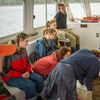Dead calm | Wayfarer Marine's controversial plans for waterfront condos lights a fire in Camden
Roger Moody figured information would soothe Camden. The town was caught in an angry debate over whether to allow Wayfarer Marine, its largest maritime business, to build condominiums on the waterfront. Supporters echoed Wayfarer's statements that it needed the revenue to survive. Opponents declared death to Camden's working waterfront if the condos were approved. Finally, in November, voters, who in this town decide major policy, denied Wayfarer's request and added insult to injury by approving a 180-day moratorium on any harbor development.
The debate about how to save the working waterfront here continues and Moody, sipping coffee recently at a café that looks across the harbor to Wayfarer's massive cherry red boat bays, admits he was surprised voters said no. He and 13 other Camden residents in 2006 created a nonprofit group called the Camden Area Futures Group to study ways to foster sustainable economic development in town. CAFG launched around the time Wayfarer revealed its controversial plans, and so Moody jumped at the chance to help facilitate a very critical decision relating so closely to CAFG's mission. CAFG looked at Wayfarer's accounting books to confirm they need the money (Moody says they do), and used a state grant to hire a professional facilitator for a series of town meetings on Wayfarer's proposal. In the end, after careful consideration, CAFG endorsed Wayfarer's plan, which Moody, a former town manager, believed supports the kind of year-round, sustainable economy he thinks Camden needs. Moody was pretty sure that if Camden voters understood the proposal as he did, the plan would win. But it lost. And now Moody just shakes his head.
"The word 'condo' is a perjorative term when it comes to waterfront," he admits grimly.
Later that day, Ray Williamson, who since 1986 has owned Windjammer Cruises next to the Wayfarer marina, sits in his living room across town flipping through two three-inch thick binders, one packed with the history of boat refitting and repair in Camden and at Wayfarer, the other dedicated to the fight over whether to allow Wayfarer to build luxury condos on that historic land.
The sundrenched home of Williamson and his wife and business partner, Ann, is immaculate and country-cozy, and Williamson, his face ruddy from a life spent sailing, is so riled up about condos on his waterfront he can't sit still. "With my business, I didn't go to the town and start crying, 'You need to give me this and you need to give me that,'" says Williamson. "If these guys [who own Wayfarer] can't dip into their pocket to do it, then they need to attract investors."
Williamson, Moody, and hundreds of other Camden voters are deciding the future of Wayfarer, and they're not taking that decision lightly. The debate over how to encourage economic development and protect the integrity of the place has preoccupied Maine's coast for decades, and it's a debate that historically leaves the working waterfront on the losing end. In Camden, to rub a little ironic sea salt in the wound, the town's largest maritime employer is the company hoping to build that harbinger of gentrification— luxury homes — to save its boat business. Ray Williamson says that's "like destroying the village to save it."
Back to the drawing board
One year ago, at a series of public meetings about development along the waterfront in Camden, Wayfarer Marine unveiled a plan to build 14 townhouse condominiums on its 9.5-acre property on the western side of Camden Harbor. (Shane Flynn, who owns Wayfarer with attorney Jack Sanford, says that plan has since been scrapped, and that Wayfarer hasn't yet replaced it with a new plan.) Wayfarer has operated in Camden as a yacht repair and refit facility, and a popular marina, for two centuries, under various names and owners, and is regarded here as the anchor of a diminishing working waterfront economy.
But though plenty here say they love Wayfarer (even Williamson says he wants the company to do well), Camden voters haven't recently shown that love. The town of Camden works according to community consensus — any significant policy changes, including zoning and business development, must be put to a town vote. And for the past two decades, the vote has not been kind to Wayfarer. Requests to work on boats in-shore at the Laite Yard off of Route 1, which is owned by former Wayfarer co-owner Parker Laite, were denied twice in town votes since 2000, the most recent this November, and an attempt to build large commercial structures on an inland part of the Wayfarer property was appealed by neighbors and went all the way to the Maine Superior Court. After years in litigation, Wayfarer won, but by then it no longer wanted to pursue the project.
In November, Wayfarer got the latest bit of bad news. Its condo proposal, though it received promising endorsements from the Camden-Rockport-Lincolnville Chamber of Commerce and the Camden Area Futures Group, met with fierce resistance in the ninth inning, when a last-minute grassroots petition placed a question about whether to suspend all development in the harbor for 180 days on the ballot alongside Wayfarer's proposal. Voters were spooked by the thought of luxury townhouses where ships once stood, and voted in favor of the moratorium and against Wayfarer's plan by a margin of two to one. Wayfarer, which said it needed the condo revenue for badly needed facilities upgrades, is now talking about walking. Right out of town. (For more on Wayfarer's facilities, see "Ship shape?" on page 35.)
Flynn, the former CEO of MBNA Europe, says the company has been approached by surrounding communities like Rockland offering to house it, and will consider moving "at some point in the future" if the town continues to restrict its attempts to expand or upgrade. "If we're not able to work on boats efficiently at our facility, in and around the water, there is no other place in Camden that's perfect where you can do the work," he says. "Clearly, to do some of the things that we will need to do in the future, we will have to look elsewhere."
Wayfarer Marine's attempt to sell condos to generate $12 million -$15 million in capital to replace and refurbish its facilities was billed in area newspapers by its owners during last year's debate as critical to its very survival. Flynn says he is heartened by the Camden Planning Board's recent rezoning ideas, which may allow for some residential development at Wayfarer. The preliminary plan, released to the public on March 12, includes residential building credits that can be earned by building maritime commercial facilities. At press time, Camden's Planning Board was refining the waterfront zoning change that will go before voters in June.
In the meantime, Wayfarer is watching the debate closely. Flynn says he has attended all of the recent planning board meetings, and insists Wayfarer needs room to move. Last year, the company booked revenue of $6 million, but is carrying more than $5 million in debt Flynn says was accumulated over the past decade or so from costs related to rebuilding or installing the boat lift and piers.
Flynn, who became an owner in January after buying out former owner Parker Laite, helped the company develop a strategic plan over the past few weeks, which includes paying down the debt. "The company needs to get itself into a healthy place," Flynn says. "If we're not going to get something that shows that [from the pending rezoning], we'll have to go back to the drawing board. We would absolutely need to decide at some stage how to continue the work we've wanted to do."
Local motions
Camden's waterfront struggles are in some ways representative of battles in towns and cities up and down the coast. One of the most influential of those fights was Portland's 1987 waterfront development moratorium, which citizens enacted to block proposed development on Fishermen's Wharf. This and other late-stage moratoriums sparked efforts to pass legislation limiting retroactive referenda, all of which have to date failed to become law.
"Camden is a great example of a really intense local effort to reach some consensus about the future of the harbor, particularly around Wayfarer's needs to stay in business," says Jim Connors, senior coastal planner for the Maine State Planning Office's Maine Coastal Program, which since 1972 has tried to help waterfront towns and cities balance economic development with historic maritime culture. "Each community has to find its own somewhat different solution. They do have to kind of duke it out at the local level."
In the meantime, the town select board, which according to town rules can only act on ordinances approved by voters, last month decided not to extend the harbor development moratorium because it was concerned the planning board would use the extra time to go overboard with its rezoning plans.
John French, an 11-year select board member and the current board chair, owns an auto repair shop near the Camden/Rockland line. French is concerned some Camden businesses have recently decided to move out of town, and as a lifelong resident, he knows the debate about how to allow businesses to mature without harming the town's integrity is only becoming more heated as the town grows.
"It's tough, I don't know the answer, nobody knows the answer," French says, pausing with grease-stained hands in his shop just down the street from Ray Williamson's home and office. "I think in a perfect world everyone would like to see Wayfarer stay the way it is. But you know, times have changed."










Comments